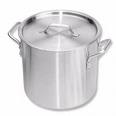Cooking for a Crowd Cookware
You need large pots when you're cooking for a large crowd!
Cooking For a Crowd? A Guide to Cookware

Are you the go-to person to cook for large crowds of friends and family? then it may be time to invest in a few pieces of large capacity cookware. It will make your job that much easier!
There are certain things you need to consider when choosing these kitchen vessels. We will look at stainless steel, aluminum, cast iron, copper, non-stick, glassware and anodized types of cookware.
What Do You Need?
Dutch Oven
If
you decide to purchase new cookware you have to decide what type and
size of cookware is going to give you the most bang for your buck. One
essential is a Dutch oven . A Dutch oven is basically a large, deep pot
with a lid.

I recommend at least a six-quart capacity pot. An eight-quart capacity is even better, especially for cooking for a crowd of 20 or more. These pots are excellent for crowd-size sauces, soups and stews. Best of all it can be used both on the stovetop and in the oven. It is great for slow-braising meats and is ideal for quantity rice recipes, freshly cooked beans and vegetables.
A large-capacity Dutch oven has a large cooking surface. This is especially important when browning meat prior to braising. To get a good caramelized brown surface, meat needs to be browned in single layer batches. A large cooking surface reduces the number of batches and if you are cooking for a crowd, you will have several pounds of meat to brown. This will save you quite a bit of time.
Roasting Pan

Another good staple, and sometimes a substitute for a Dutch oven, is a roasting pan. Roasting pans range from about 16 to 20 inches long and 11 to 14 inches wide. They generally come with either upright or side handles and can be open or covered, non-stick or anodized.
I prefer the upright handles which give you a more secure grip. These pans provide a very large cooking surface and when used on the stovetop are placed over two burners (front to back). In the oven and with the use of a roasting rack, they are perfect for turkeys, prime rib, whole chickens and duck.
When Size Matters...Stock Pot

Stock pots are generally of 8-quart capacity and over and are taller then a Dutch oven, with a smaller cooking surface. They are preferred for very large quantities of soup, gumbo and well, for making stock.
I love to use a stock pot for boiling lobsters, indoor seafood boils and to cook very large quantities of pasta. They are a little awkward to handle so make sure you have a clear landing spot when you maneuver these big boys.
How to Purchase Cookware
Look for cookware that is low maintenance, easy to clean and that has good heat conduction. Did I say easy to clean?
What To Look For
How Well Does It Conduct Heat?
Some metals are better heat conductors than others. The better the heat conduction the better and more evenly your food will cook.
Is It Durable?
Stainless steel is considered to be one of the most durable materials. You will actually get a better return of your investment if you purchase a long-lasting product
Maintenance
Copper cookware generally requires quite a bit of work to keep it looking shiny and bright, while stainless steel is almost as easy to clean as non-stick cookware.
Price
The amount you pay for your cookware will most likely be a determining factor in what you eventually buy.
Think about what pieces of cookware you need before you buy. Even though purchasing a cookware set can be less expensive than buying piece by piece; if you don't use it you will be paying more in the end!
Be realistic. The bottom line, as with anything...buy the best you can afford.
Purchasing Guide
Use this chart as a starting guide before you purchase cookware. Hope it helps!
Heat Conduction
Durability
Maintenance
Price
Other Info
Stainless Steel
Ok, but not as good as others
Very
Almost as easy as non-stick to clean
Relatively inexpensive
Does not react with foods
Aluminum
Excellent
Scratches and dents easily
Easily burns and sticks; will rust
Relatively inexpensive
Reacts with acidic foods
Cast Iron
Great
Last forever
Must be seasoned; do not use soap to clean
Can be expensive
Food sticks if not seasoned
Copper
Excellent
Good
Lots of polishing; tarnishes
Expensive
Reacts with acidic foods
Anodized
Excellent
Good
Easy clean
Some can be expensive
Made by "electrifying"
aluminum
(anodization), creating a durable non-stick surface
Glassware
Fair, good for baking
Good, but handle with care (it is glass)
Will stick if not properly oiled; dishwasher safe
Relatively inexpensive
Good for freezing food; let rest at room
temperature for 15 mins or more before going from freezer to oven, may shatter
Teflon® cookware has not been included here because it has been found to release certain toxic gases when cookware is used over high heat for long periods of time. As of 2014, Teflon cookware is no longer being manufactured.
Comments
Have your say about what you just read! Leave me a comment in the box below.